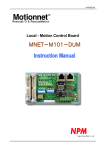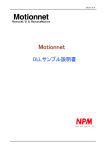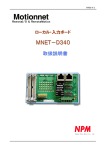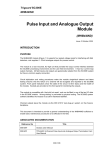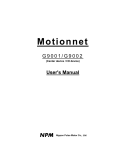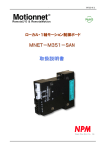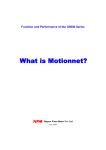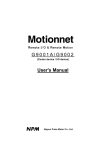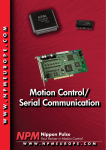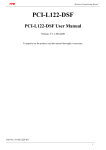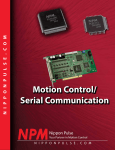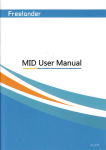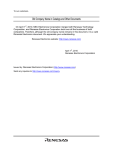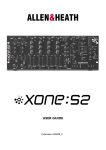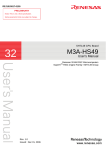Download MNET-D304 User`s Manual
Transcript
YA7084-0/1 R RemoteI/O & RemoteMotion Local Output Board Nippon Pulse Motor Co., Ltd. Motionnet Local Output Board MNET-D304 YA7084-0/1 Table of Contents 1. Preface...................................................................................................................................................... 1 2. Features.................................................................................................................................................... 3 3. Handling Precautions.............................................................................................................................. 4 4. Warranty Period and Coverage .............................................................................................................. 4 5. Specifications .......................................................................................................................................... 5 6. Configuration ........................................................................................................................................... 7 7. Connector Pin Assignment..................................................................................................................... 8 7-1. CN1 (output signal connector 1) ..................................................................................................... 8 7-2. CN2 (output signal connector 2) ..................................................................................................... 8 7-3. CN3, 4 (serial communication connector) ..................................................................................... 9 7-4. CN5 (power connector) .................................................................................................................... 9 7-5. Connectors used .............................................................................................................................. 9 8. Signals and Functions .......................................................................................................................... 10 8-1. Output signal (OUT*, OUTCOM*+, OUTCOM*-)............................................................................ 10 8-2. Serial communication (RS485+, RS485-) ......................................................................................11 8-3. Power requirements (24V, GND, FG) .............................................................................................11 9. Settings................................................................................................................................................... 12 9-1. Setting the serial communication device number (SW1) ........................................................... 12 9-2. Setting the serial communication parameters (SW2) ................................................................. 12 9-2-1. Setting the data transfer speed (B0, B1) ............................................................................... 12 9-2-2. Setting the output signal status to use when a communication error occurs (TD) ......... 12 9-2-3. Setting the watchdog timer (TM)............................................................................................ 13 9-2-4. Break frame request (BK) ....................................................................................................... 13 9-2-5. Setting the termination resistance (TR) ................................................................................ 13 10. Status Display ...................................................................................................................................... 14 10-1. Communication status display LED (RUN)................................................................................ 14 10-2. Communication status display LED (ERR) ................................................................................ 14 10-3. Power indicator LED (3.3 V)......................................................................................................... 14 10-4. Input/Output signal display LED ................................................................................................. 14 11. Serial Communication Connection Cable ......................................................................................... 15 12. Allocation of Switches and Connectors............................................................................................ 16 13. External Dimensions ........................................................................................................................... 17 - C1 - R RemoteI/O&RemoteMotion Motionnet Local Output Board MNET-D304 YA7084-0/1 1. Preface Thank you for purchasing our output board, a local board from our Motionnet ultra-high speed serial communication system series. □ The MNET-D304 board you have purchased is a 32 point parallel output board which contains a G9002 IO device for ultra-high speed serial communication. This board is controlled by a center board, which is equipped with a G9001A Motionnet Center device. Use the center board together with this board. □ Motionnet is an ultra-high-speed serial communication system created by NPM (Nippon Pulse Motor). Using our four specially developed devices (G9001A, G9002, G9003, and G9004) as core chips, this serial communication system is a complete system for reducing wiring while affording remote operation by emulating a CPU and handling CPU message communications, as well as controlling input and output, at transfer speeds of 20 Mbps. Device G9001A: Center device This is a central controller that manages local devices. This device has 256 bytes of RAM for I/O control, and 512 bytes for data communication. This device can be operated from a remote CPU just like accessing a memory. It can be connected to a maximum of 64 local devices (G9002, G9003, and G9004). G9002: IO device This is a local I/O control device that can control 32 separate I/O signals. G9003: PCL device This is a local device containing a pulse control LSI that has been developed and polished by NMP for use in motion control over many years. It also has a serial communication function. It can control single-axis pulse input type stepper motors and servomotors. G9004: CPU emulation device This is the most sophisticated local device in the Motionnet series, and it can remotely control other LSIs that need a connection to a CPU (for example a PCL6045B made by NPM). By connecting a CPU to its local side, it can also communicate messages between CPUs. RemoteI/O If a Motionnet line is only used for input and output control, it can send and receive signals for 2048 points on 64 local devices in 0.97 msec (using a 20 Mbps data transfer speed). (If a smaller number of devices are connected, the data transfer time will be proportionally shorter.) RemoteMotion If a Motionnet line is only used to control motors, it can control up to 64 axes. With this type of control, individual devices can control pulse-input type stepper motors and servomotors. They can execute continuous operations at constant speed, linear acceleration/deceleration, and S-curve acceleration/deceleration, as well as carry out preset positioning operations, and zero return operations. -1- R RemoteI/O&RemoteMotion Motionnet Local Output Board MNET-D304 YA7084-0/1 A system combining these two motor types is also possible. Although it depends on the number of devices connected and the data transfer speed selected, the cable length can be extended up to 100 m using an ordinary CAT5 LAN cable. The serial communication uses a receive-respond type protocol. This protocol adds a CRC number to the communication frame to detect errors, thus offering higher reliability. You can use it without worrying about the accuracy of the communication. □ This instruction manual describes the specifications and methods for using the MNET-D304. We want you to read this manual thoroughly and get full use of the functions offered by this board. This manual does not describe the detailed functions of the G9001A and G9002 LSIs for ultra-high-speed serial communication systems. For the details about the functions and registers of these LSIs, please read NPM's "User's Manual for the G9001A/G9002, LSIs for the Motionnet ultra-high speed serial communication system." -2- R RemoteI/O&RemoteMotion Motionnet Local Output Board MNET-D304 YA7084-0/1 2. Features Data transfer speed 20 Mbps, maximum Data transfer cycle A maximum of 0.97ms, when using 64 I/O boards. (At a transfer speed of 20 Mbps, and using our recommended 50 m cable.) Number of devices that can be connected Maximum 64 I/O boards/line, with 2048 points connected. Connection method Multi-drop connections using LAN cables. Serial communication types Three types of communication are available. 1) System communication By polling the Motionnet line, the number of local devices that are connected, the device numbers, device types, and I/O port allocation status can all be checked. 2) Cyclic communication The system starts communication with the local device that has the lowest device number. When the communication cycle reaches the device with the highest device number, the system starts over again, communicating with the device that has the lowest device number. The process of communicating with all active devices, from the lowest to the highest device, is one cycle. The system always repeats this communication cycle, automatically. Input and output are controlled using cyclic communication. 3) Data communication This type of communication is used to read and write data between a PCL device and a CPU emulation device. Data is written into a FIFO buffer in the center device, and then a send command is issued. These communications are sent and received automatically, during the interrupt driven cyclic communications. Communication error detection Errors can be detected by adding CRC numbers to the serial communication frames. Output - Number of output points: - Isolation method: - Output interface: 32 points Photocouplers Darlington transistor output Common output specifications 8 output points are configured as one group. This group is independent from all other groups. Each group has one common line. Using jumpers, they can be connected to the power supply that is also supplying power to the power connector. -3- R RemoteI/O&RemoteMotion Motionnet Local Output Board MNET-D304 YA7084-0/1 3. Handling Precautions Inputting power Do not connect or disconnect connectors while this board or peripheral circuits are supplied with power. Static electricity This board uses a CMOS device. Therefore this board must be stored in a package in which it was shipped until you actually use it, in order to prevent damage from static electricity. Switch settings This board is equipped with switches to set device number and details for serial communication. Be sure to shut off the power supply to the board before changing these switches. Connections to electrically noisy devices Interference from excessively noisy devices or from power surges on the power and I/O circuits may cause the board to malfunction. To connect to a device, which may generate electrical noise, we recommend taking countermeasures, such as attaching a protective circuit to the input/output circuits. However, it is best not to share the same power supply with noise generating sources. Heat generation of circuit elements Input resistors, output transistor arrays, and other elements may generate heat and thus become hot, depending on the operating conditions. If this happens, take steps such as using forced cooling. 4. Warranty Period and Coverage Warranty period 12 months after being shipped from our factory. Warranty coverage During the warranty period, we will repair without charge any problems on the board that occurred while it was being used appropriately, and where the cause of the problem is due to us. However, the following cases will be not be covered by the warranty, even if the warranty period has not expired. - Problems caused by inappropriate handling or use. - Problems caused by using parts not made or approved by us. - Problems caused by modifications made to the board that were not authorized by NPM. - Problems caused by disasters, accidents, or fires. We warranty only the product as delivered, and we do not accept responsibility for any loss caused by a fault in our product. We will repair the board when the user sends it to our plant. -4- R RemoteI/O&RemoteMotion Motionnet Local Output Board MNET-D304 YA7084-0/1 5. Specifications Specifications of this board are shown below. Signal Item name Maximum of 0.12 msec, when using 8 devices. #1 Maximum of 0.24 msec, when using 16 devices. #1 Maximum of 0.49 msec, when using 32 devices. #1 Maximum of 0.97 msec, when using 64 devices. #2 (Data transfer speed: 20 Mbps, when using our recommended cable #1:100m, #2: 50m) Maximum of 100 m (At a data transfer speed of 20 Mbps with 32 devices connected) Maximum of 50 m (At a data transfer speed of 20 Mbps with 64 devices connected) Maximum of 100 m (At a data transfer speed of 10 Mbps with 64 devices connected) (Using our recommended cables) Pulse transformer and RS-485 specification line transceiver Our proprietary protocol Cyclic communication times and data transfer cycles Total serial communication line length Serial communication interface Serial communication protocol Serial communication coding method Serial communication method NRZ signed Connection method Serial communication device number Serial communication transfer speed SW1A0 to A5 SW2B0, B1 Output status setting when a communication error occurs SW2-TD Watchdog timer setting SW2-TM Break frame request SW2-BK Termination resistance setting SW2-TR Display serial communication status RUN ERR Input/output status display Selection of a common line G9002 reference clock -5- Specifications JP1 to 8 Half-duplex communication Multi-drop connection using a LAN cable or our proprietary cable. Assignable device numbers, 0 to 63. Set using switches. 20 Mbps/10 Mbps/5 Mbps/2.5 Mbps Set using switches. Maintain current status / Reset Select one using a switch (The selected output is used when the watchdog timer times out during communication) When 20 Mbps is selected: 20ms / 5ms When 10 Mbps is selected: 40ms / 10ms When 5 Mbps is selected: 80ms / 20ms When 2.5 Mbps is selected: 160ms / 40ms Select one of the above using a switch. (This is the data sending interval allowed by the center device.) Send a break frame. Set using a switch. Enable termination resistance on the last device on a serial line. Set using a switch. RUN: While receiving serial communications normally, the green LED is lit. ERR: When a serial communication error occurs continuously, the red LED is lit. Input: The green LED goes on when the input photocoupler turns on. Output: The red LED goes on when the output transistor turns on. Connection between the input/output circuit commons and CN5, the input power terminal. Set using a jumper connector. 80 MHz R RemoteI/O&RemoteMotion Motionnet Local Output Board MNET-D304 Item Signal name Output Power requirements Power indicator Operating temperature range *1 Operating ambient humidity Vibration proof CN5-24 V, GND 3.3 V YA7084-0/1 Specifications - Number of points: 32 (one common line for each 8 points) - Open collector output (sink type using Darlington transistors) - Max. rated voltage: 50 VDC - Recommended operating voltage; 12 to 24 VDC - Max. output current (when 8 circuits are switched on at the same time) 80 mA/point (when the pulse width is 25ms and the duty cycle is 50 % while operating at 24 VDC) 20 mA/point (when always on while operating at 24 VDC) - Response time: 55 µsec (Typ.) (when a 20 mA load is applied while operating at 24 VDC) - Overcurrent protection: 2.5 A (in 8 point units) - Output saturation voltage Vce (sat) = 0.9 V (Typ.) (Ic = 100 mA) 24 VDC±10%, 100 mA (Typ.) (The current value given above is true when 24 VDC is input and there is no connection with the input/output circuit common.) Yellow LED Indicates that 3.3 VDC internal control power is being output. 0 to +40˚C 80%RH or less (Non condensing through the +10˚C to +40˚C range) Complies with JIS C0040 Using DIN rail. Installation method (DIN rails are not supplied as accessory.) Dimensions W124x D72.5 x H50 (Unit: mm) *1: The output transistors have a loss of 0.11 W per point (at 24 VDC). Consider the heat generated by these transistors in use. -6- R RemoteI/O&RemoteMotion Motionnet Local Output Board MNET-D304 YA7084-0/1 6. Configuration A block diagram is shown below. G9002 Motionnet IO device Serial communication line CN3 Pulse RS-485 line transformer transceiver SO SOEH SI CN1 Output interface P00 to P07 OUT1 to OUT8 OUTCOM1+ OUTCOM1- CN4 Device number setting switch Output interface P10 to P17 OUT9 to OUT16 OUTCOM2+ OUTCOM2- DN0 to 5 SW1 Serial communication setting switch SW2 CN2 SPD0, 1 TUD P20 to P27 TMD BRK Output interface OUT17 to OUT24 OUTCOM3+ OUTCOM3- Output interface OUT25 to OUT32 OUTCOM4+ OUTCOM4- Quartz oscillator CLK P30 to P37 80MHz CN5 DC/DC converter 5V, 3.3V 24V GND FG Common selection OUTCOM1+ to 4+ OUTCOM1- to 4JP1 to 8 -7- R RemoteI/O&RemoteMotion Motionnet Local Output Board MNET-D304 YA7084-0/1 7. Connector Pin Assignment 7-1. CN1 (output signal connector 1) Connect 16 points of output signals. No. Signal name Function No. Signal name Function 1 OUT1 Output signal 1 2 OUTCOM1+ Output signal common 1+ 3 OUT2 Output signal 2 4 OUTCOM1+ Output signal common 1+ 5 OUT3 Output signal 3 6 OUTCOM1+ Output signal common 1+ [7 OUT4 Output signal 4 8 OUTCOM1+ Output signal common 1+ 9 OUT5 Output signal 5 10 OUTCOM1+ Output signal common 1+ 11 OUT6 Output signal 6 12 OUTCOM1+ Output signal common 1+ 13 OUT7 Output signal 7 14 OUTCOM1+ Output signal common 1+ 15 OUT8 Output signal 8 16 OUTCOM1- Output signal common 117 OUT9 Output signal 9 18 OUTCOM2+ Output signal common 2+ 19 OUT10 Output signal 10 20 OUTCOM2+ Output signal common 2+ 21 OUT11 Output signal 11 22 OUTCOM2+ Output signal common 2+ 23 OUT12 Output signal 12 24 OUTCOM2+ Output signal common 2+ 25 OUT13 Output signal 13 26 OUTCOM2+ Output signal common 2+ 27 OUT14 Output signal 14 28 OUTCOM2- Output signal common 229 OUT15 Output signal 15 30 OUT16 Output signal 16 7-2. CN2 (output signal connector 2) Connect 16 points of output signals. No. Signal name Function No. Signal name Function 1 OUT17 Output signal 17 2 OUTCOM3+ Output signal common 3+ 3 OUT18 Output signal 18 4 OUTCOM3+ Output signal common 3+ 5 OUT19 Output signal 19 6 OUTCOM3+ Output signal common 3+ 7 OUT20 Output signal 20 8 OUTCOM3+ Output signal common 3+ 9 OUT21 Output signal 21 10 OUTCOM3+ Output signal common 3+ 11 OUT22 Output signal 22 12 OUTCOM3+ Output signal common 3+ 13 OUT23 Output signal 23 14 OUTCOM3+ Output signal common 3+ 15 OUT24 Output signal 24 16 OUTCOM3- Output signal common 317 OUT25 Output signal 25 18 OUTCOM4+ Output signal common 4+ 19 OUT26 Output signal 26 20 OUTCOM4+ Output signal common 4+ 21 OUT27 Output signal 27 22 OUTCOM4+ Output signal common 4+ 23 OUT28 Output signal 28 24 OUTCOM4+ Output signal common 4+ 25 OUT29 Output signal 29 26 OUTCOM4+ Output signal common 4+ 27 OUT30 Output signal 30 28 OUTCOM4- Output signal common 429 OUT31 Output signal 31 30 OUT32 Output signal 32 -8- R RemoteI/O&RemoteMotion Motionnet Local Output Board MNET-D304 YA7084-0/1 7-3. CN3, 4 (serial communication connector) Connect the Motionnet serial signal. The corresponding pins of CN3 and CN2 are internally connected. No. Signal name Function No. Signal name Function 1 N.C. 2 N.C. 3 RS485+ Serial communication data+ 4 N.C. 5 N.C. 6 RS485Serial communication data7 N.C. 8 N.C. Note 1: N.C. means Not Connected. Note 2: The connector frames are connected to the FG terminal on the power connector. 7-4. CN5 (power connector) Power connections No. Signal name Function No. Signal name Function 1 24V Power, 24 VDC 2 GND Ground 3 FG Frame ground 4 24V Power, 24 VDC 5 GND Ground 6 FG Frame ground 7-5. Connectors used The manufacturer model names of the connectors used on this board are shown below. Nbr. Mfg. Model name Remarks CN1 3M 3440-6002LCSC or equivalent MIL standard, 30-pin box pin header CN2 〃 〃 〃 Hirose CN3 TM11R-3C-88 or equivalent 8-pin modular jack connector Electric CN4 〃 〃 〃 Board side: XW4A-06B1-V1 or equivalent Connector terminal block 3.81 mm CN5 Omron Cable side: XW4B-06B1-H1 or equivalent pitch This board does not come with any connectors for other devices owned by the user. To choose these connectors, we recommend the following items. Nbr. Item name Mfg. Model name Remarks 7930-6500SC Crimp connector, 1.27 mm pitch for For CN1 Connector 3M 3448-7930 flat cable, with a strain relief For CN2 〃 〃 〃 〃 For CN3 Modular plug Hirose electric TM11P-88P Modular plug, with a shield For CN4 〃 〃 〃 〃 -9- R RemoteI/O&RemoteMotion Motionnet Local Output Board MNET-D304 YA7084-0/1 8. Signals and Functions 8-1. Output signal (OUT*, OUTCOM*+, OUTCOM*-) Function These are output signals for general use. Output signal interface 1) Number of output signal points This board has 32 parallel output signal points, and a + common and a - common for each group of 8 points. The commons can be connected to the power that is supplied to the power connector using jumper lines JP1 to JP8. 2) The output signal terminals are assigned to the following terminals on the G9002. OUT 1 to 8: P00 to P07, OUT 9 to 16: P10 to P17 OUT17 to 24: P20 to P27, OUT25 to 32: P30 to P37 3) The open collector output signals are isolated from the internal power supply using photocouplers (Darlington transistor: TD62081AF or equivalent, with 8 elements) 4) Eight 2.5A overcurret protection fuses are placed on the emitter side of the transistors. 5) Logic Transistors are turned on as ‘active-high’. (Positive logic) (By writing a “1” to an output signal bit, the respective transistor will go on.) [Output signal specifications] - Recommended operating voltage: 12 to 24 VDC ・Maximum output signal current (When 8 circuits go on at the same time) 80mA/point (pulse length: 25ms, duty cycle: 50%, operating at 24 VDC) 20mA/point (always ON, operating at 24 VDC) - Saturation voltage: Vce (sat) = 0.9 V (Typ.) (Ic = 100 mA) TLP280 or equivalent 0.3 W, 3.3 KΩ OUTCOM1+ OUT1 TD62081AF or equivalent TLP280 or equivalent 0.3 W, 3.3 KΩ OUT8 TD62081AF or equivalent OUTCOM1- 2.5 A CN5 JP1 24V JP2 - 10 - GND R RemoteI/O&RemoteMotion Motionnet Local Output Board MNET-D304 6) Common signal lines and jumpers Common JP OUTCOM1+ JP1 OUTCOM2+ JP3 OUTCOM3+ JP5 OUTCOM4+ JP7 YA7084-0/1 Common OUTCOM1OUTCOM2OUTCOM3OUTCOM4- JP JP2 JP4 JP6 JP8 8-2. Serial communication (RS485+, RS485-) Function These are the Motionnet serial signals. Interface 1) Serial communication signals are isolated by using a pulse transformer. They are input and output by a line transceiver (SN65HVD1176D or equivalent) that meets the RS-485 specifications. The board inputs/outputs the forward phase of the line transceiver through the RS485 plus side and the reverse phase through the RS485 minus side terminals. 2) Termination resistance In order to prevent reflection of the serial communication line signals, termination resistors must be present at the start and end points of the line. The serial communication setting witch (SW2) is used to enable/disable the termination resistance. By turning on this switch, the termination resistance of 120 ohm is enabled on the board. Be sure to turn this switch on if the board is the last one on the serial communication line. G9002 SO SOEH RS-485 line transceiver SN65HVD1176D or equivalent A CN3 Pulse transformer DP101-102F or equivalent 3 6 B SI SW2 TR RS485+ RS485- 120Ω CN4 3 6 RS485+ RS485- *1 FG *1: The connector frame is connected to the FG terminal of power connector. 8-3. Power requirements (24V, GND, FG) Function These are terminals used to supply control power to the board. The 5 V and 3.3 V internal control voltages are created from these lines using an isolated DC/DC converter. The power terminals can be connected to the common lines of the input/output signal circuits using jumpers. The frame ground (FG) is connected to the serial communication connector case. Be sure to ground the FG to the ground. - 11 - R RemoteI/O&RemoteMotion Motionnet Local Output Board MNET-D304 YA7084-0/1 9. Settings 9-1. Setting the serial communication device number (SW1) Set the device number for Motionnet serial communication using switch SW1. Set a device number that is not being used by any other device on the same serial communication line. You do not need to set the device numbers sequentially. Pick any number between 0 and 63. Switches A0 to A5 correspond to the values 1, 2, 4, 8, 16, and 32, respectively. The device number will be the sum of the numbers for the switches that are turned on. When delivered, the device number is set to 0. SW1 ON The example on the left means “13d” in decimal or “Dh” in hexadecimal. 1 2 3 4 5 6 A A AAA A 5 4 32 1 0 9-2. Setting the serial communication parameters (SW2) Set the parameters for Motionnet serial communications using switch SW2. When delivered, all these switches are off. SW2 ON 1 2 3 4 5 6 B B TTB T 1 0 D MK R 9-2-1. Setting the data transfer speed (B0, B1) Specify a data transfer speed. Use switches B0 and B1 to choose from four speeds. B1 (SW2-1) B0 (SW2-2) Transfer speed OFF OFF 20 Mbps OFF ON 10 Mbps ON OFF 5 Mbps ON ON 2.5 Mbps 9-2-2. Setting the output signal status to use when a communication error occurs (TD) Select the output signal state to use when the communication status watchdog timer times out. Choose from the desired setting below using the TD switch. TD (SW2-3) Output signal status OFF Maintains the current status of the output signal ON Turns off the output signal transistor (reset status) The signal inputs will not be affected by this setting. - 12 - R RemoteI/O&RemoteMotion Motionnet Local Output Board MNET-D304 YA7084-0/1 9-2-3. Setting the watchdog timer (TM) Set the time for the watchdog timer that is used to monitor the communication status. When the interval between data communications from a center board, on which the G9001 is mounted, exceeds the time set here, the watchdog timer will time out. Possible causes of a time out are an abnormality on the serial communication line, and that the center board communication has stopped. This interval time varies with the data transfer time selected. Watchdog timer time out interval TM (SW2-4) At 20 Mbps At 10 Mbps At 5 Mbps At 2.5 Mbps OFF ON 5 ms 20 ms 10 ms 40 ms 20 ms 80 ms 40 ms 160 ms 9-2-4. Break frame request (BK) This function is used to add to the number of local boards, or to restore a specific local board that has previously been excluded from cyclic communication due to a communication error. The center board on which the G9001 is mounted sends regular break frame sending request data (approximately every 250ms at 20 Mbps) to local devices. A local device which has sent a break frame request will respond this communication from the center device. When the center board confirms the response, the corresponding status bit “BRKF” will be changed to “1” and an interrupt will occur. With this sequence, the center board realizes that a local board has been added to the communication line. BK (SW2-5) Break frame OFF ON Break frame request 9-2-5. Setting the termination resistance (TR) Set the termination resistance on a serial communication line. Turn the switch on to enable the termination resistance. TR (SW2-6) Termination resistance OFF ON Enable the termination resistance - 13 - R RemoteI/O&RemoteMotion Motionnet Local Output Board MNET-D304 YA7084-0/1 10. Status Display 10-1. Communication status display LED (RUN) When the G9002 in the local board receives serial communications data successfully, the MSEL LED will be lit green. If there are a lot of local boards connected to the serial communication line, the LED may be somewhat dimmed. This LED is green. 10-2. Communication status display LED (ERR) When an error occurs, such as a CRC error in the serial communication data, the G9003 MRER LED is lit red. 10-3. Power indicator LED (3.3 V) Shows that 3.3 VDC is available internally. Lights yellow. 10-4. Input/Output signal display LED When any of the input/output signals goes on, this LED goes on. It lights green when inputs signals are detected and it lights red when output signals are sent. - 14 - R RemoteI/O&RemoteMotion Motionnet Local Output Board MNET-D304 YA7084-0/1 11. Serial Communication Connection Cable This system guarantees enhanced quality for high-speed communication, and is designed to be connected with LAN cables suitable for 100BASE and 1000BASE. These are standard cables, easy to find and cheap. Therefore, we do not include these cables with our products. To select cables you need to connect, make sure they meet the following specifications. Wiring standard: TIA/EIA-568-B Category 5 (CAT5) Enhanced category 5 (CAT5e) Category 6 (CAT6) UTP (UnShieldedTwistedPair) cables or STP (ShieldedTwistedPair) cables that meet the specifications above. The higher the standard the cables meet, the more the communication quality will be improved. To use the board in an area with excessive electrical noise, use shielded cables (STP). Observe the following when connecting your system. 1) Total serial line length This system employs a multi-drop connection method. The maximum total extension distance of the line varies, depending on the data transfer speed and the number of local boards that are connected. - Max. 100 m (Transfer speed; 20 Mbps with 32 local boards connected) - Max. 50 m (Transfer speed; 20 Mbps with 64 local boards connected) - Max. 100 m (Transfer speed; 10 Mbps with connecting 64 local boards connected) 2) Minimum cable length The shortest cable must be at least 60 cm long. 3) Do not mix cables of different types and model in the same serial line. 4) Keep the total serial line length as short as possible. 5) If you are using shielded cables, do not connect the shield on both ends to the FG terminals. Connecting only one end of the shield on each cable will improve noise immunity. Multi-drop connection Center board - 15 - Local boards R RemoteI/O&RemoteMotion Motionnet Local Output Board MNET-D304 YA7084-0/1 12. Allocation of Switches and Connectors Shown below is the layout of the connectors and switches. Output connector (CN1) Output connector (CN2) Input/output display LED Serial communication connector (CN3, 4) Setting serial communication (SW2) Setting device number of serial communication (SW1) Communication status display LED (RUN) Communication status display LED (ERR) Power indication LED (3.3V) Jumper connectors for common selection (JP1 to 8) Item Serial communication device number assignment (SW1) Power connector (CN5) Setting details Assign a device number for serial communication. ON: 1, OFF: 0. The example below sets “13d” as the device number. SW1 (Default setting: “0d”) ON 1 2 3 4 5 6 A A AAA A 5 4 32 1 0 Common selection connector (JP1to 8) JP Common JP JP1 OUTCOM1+ JP2 JP3 OUTCOM2+ JP4 JP5 OUTCOM3+ JP6 JP7 OUTCOM4+ JP8 (Default setting: All open) Common OUTCOM1OUTCOM2OUTCOM3OUTCOM4- Item Setting details Serial communication assignment (SW2) - Set transfer speed (B0, B1) B0 B1 Transfer speed OFF OFF 20 Mbps ON OFF 10 Mbps OFF ON 5 Mbps ON ON 2.5 Mbps - Set the output signal status to use when a communication error occurs (TD) TD Output signal status OFF Maintain the current output status ON Turn off the output signal transistor (reset status) - Set the watch dog timer time (TM) Watch dog timer time TM 20Mbps10Mbps 5Mbps 2.5Mbps OFF 5ms 10ms 20ms 40ms ON 20ms 40ms 80ms 160ms - Break frame request (BK) ON: Request a break frame ・Set termination resistance (TR) ON: Use termination resistance (Default setting: All off) SW2 ON 1 2 3 4 5 6 B B TTB T 1 0 D MK R - 16 - R RemoteI/O&RemoteMotion Motionnet Local Output Board MNET-D304 YA7084-0/1 13. External Dimensions The external dimensions of this board are shown below. (DIN rails are not supplied as accessory for this board). Unit: mm - 17 - R RemoteI/O&RemoteMotion Motionnet Local Output Board MNET-D304 YA7084-0/1 The descriptions in this manual may be changed without prior notice to CAUTION improve performance or quality. Nippon Pulse Motor Co., Ltd. Tokyo business site: 6-1, Sakaecho, Tachikawa City, Tokyo, 190-0003, Japan TEL: 81-42-534-7701 FAX: 81-42-534-0017 Osaka sales office: 1-2-1-2504, Benten, Minato Ward, Osaka city, 552-0007 TEL: 81-6-6576-8330 FAX. 81-6-6576-8335 URL: //http://www.pulsemotor.com/ E-mail: [email protected] Issued in March 2008 - 18 - R RemoteI/O&RemoteMotion






















